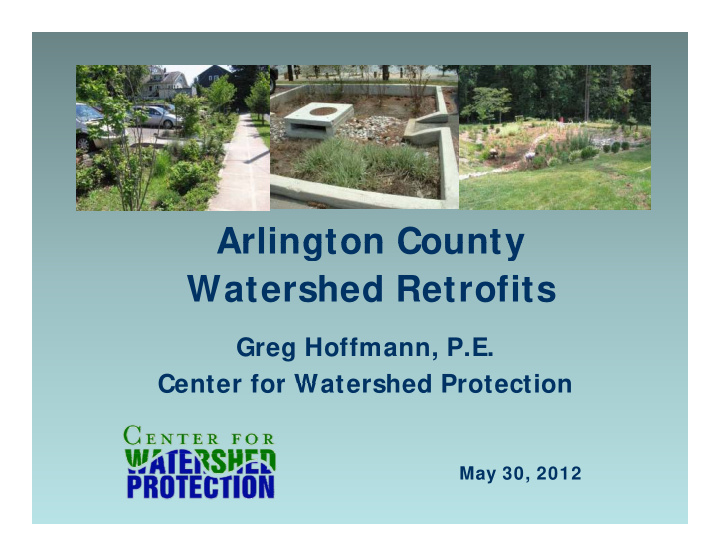



Arlington County Arlington County Watershed Retrofits Greg Hoffmann, P.E. Center for Watershed Protection Center for Watershed Protection May 30, 2012
About the Center for Watershed Protection W t h d P t ti • Non-profit 501(c)3 non-advocacy • Non profit 501(c)3, non advocacy organization • Work with watershed groups local state • Work with watershed groups, local, state, and federal governments • Provide tools communities need to protect P id t l iti d t t t and restore streams, lakes, and rivers • 21 staff in MD, VA, NY www.cwp.org p g
Stormwater Retrofits Stormwater Retrofits • Stormwater retrofits are • Stormwater retrofits are just one type of urban watershed restoration practice. • Others include: – Stream Repair St R i – Riparian Management – Illicit Discharge Prevention – Watershed Forestry – Pollution Prevention – Municipal Good Housekeeping www.cwp.org p g
Retrofitting is Different Retrofitting is Different • Retrofitting is different than new stormwater Retrofitting is different than new stormwater design • Retrofitting requires: – Sleuthing skills to determine what can work at highly constrained sites – Simultaneously envisioning restoration possibilities y g p and anticipating potential problems • Design, permitting and construction of stormwater retrofit practices is almost always stormwater retrofit practices is almost always more complex than new stormwater management practices
Retrofitting is Challenging • It can be difficult to find enough retrofit l locations to meet restoration objectives ti t t t ti bj ti – Required storage volumes can get prohibitively large particularly when channel protection and large, particularly when channel protection and flood control are restoration objectives – Depending on watershed condition and restoration objectives, many retrofit sites may be needed – The more impervious a watershed becomes – The more impervious a watershed becomes, the more storage is required and the more difficult it becomes to find retrofit sites
Our Retrofit Approach Our Retrofit Approach • Articulate realistic and measurable restoration goals • • Apply to small Apply to small subwatersheds (less than 10 square miles) • Utili e apid methods to find Utilize rapid methods to find, design and implement a variety of restoration practices ti
Step 1: Retrofit Scoping • Purpose – Define a retrofit strategy to meet local restoration objectives • Key tasks – Review local stormwater management infrastructure and practices – Define restoration objectives – Define preferred retrofit locations and practices
Arlington County Retrofit Objectives Primary Objectives 1. Treat stormwater runoff to eliminate pollutants. p 2. Promote runoff reduction to the extent achievable. 3. Address pollution hotspots where appropriate. Secondary Objectives 4. Alleviate existing drainage problems when feasible. 5 5. I Implement safe, aesthetically beneficial retrofits. l t f th ti ll b fi i l t fit 6. Provide outdoor learning and outreach opportunities. 7 7. Create desirable wildlife habitat areas Create desirable wildlife habitat areas. 8. Support existing recreational uses and naturalization efforts.
Preferred Retrofit Locations & Practices Different types of stormwater management practices used in stormwater retrofitting p g
Extended Detention, Wet Ponds, and Wetlands
Bioretention, Filtration, I nfiltration, & Swales
Bioretention in Action Bioretention in Action
Patrick Henry Drive Drive
Green Roofs, Cisterns, & P Permeable Pavement bl P t
Step 2: Desktop Analysis Step 2: Desktop Analysis • Purpose – Rapidly search for and identify potential retrofit sites across the subwatershed – Save time in the field S ti i th fi ld
Step 3: Retrofit Reconnaissance I nventory (RRI ) Reconnaissance I nventory (RRI ) • Purpose – Determine feasibility of candidate retrofit locations – Collect information • Key tasks – Evaluate potential retrofit sites, collect pertinent site information and produce a basic design sketch information, and produce a basic design sketch
Typical Arlington County Retrofit Locations 1. Local Streets
Typical Arlington County Retrofit Locations 1. Local Streets
Typical Arlington County Retrofit Locations 2. Public Land
Typical Arlington County Retrofit Locations 3. I nstitutional Properties
Typical Arlington County Retrofit Locations 3. I nstitutional Properties
Typical Arlington County Retrofit Locations 4. Large I mpervious Properties
Step 4: Compile Retrofit I nventory • Purpose – Communicate the results of the field assessments. – Provide the information needed to develop an implementation plan implementation plan. • Key tasks – Catalogue the field assessment data. Catalogue the field assessment data – Rank and prioritize projects. – Develop concept designs for the most highly rated Develop concept designs for the most highly rated projects.
Small Group Activity 1.Mark your house on the watershed map. 2 Di 2.Discuss possible retrofit locations, ibl t fit l ti opportunities, and challenges. 3.Note retrofit opportunities on map, and write a short description. write a short description.
Recommend
More recommend